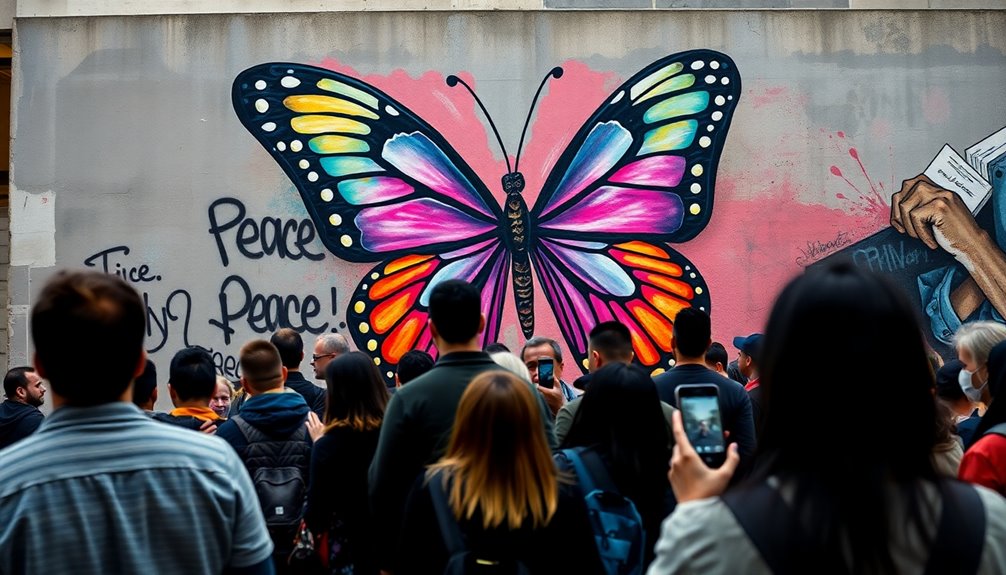Symbolism works by using symbols—like objects, colors, or characters—to express deeper meanings and ideas. These symbols help you connect with the story on a whole new level. For example, a red rose might represent love, instantly evoking emotion. Context plays a big role, too; the meaning of a symbol can change depending on the setting and culture. Recognizing symbols can enrich your understanding of themes and characters. As you explore stories, you'll find that symbols can reveal exciting layers of meaning. Stick around to discover more fascinating insights about how symbols add depth to storytelling!
Key Takeaways
- Symbolism conveys deeper meanings through symbols, allowing abstract concepts to be represented by tangible images that enhance narrative richness.
- Context plays a crucial role in shaping the interpretation of symbols, influencing their meanings based on narrative settings and author backgrounds.
- Universal symbols have shared meanings across cultures, while contextual symbols are tied to specific characters and plots, deepening understanding.
- Misinterpretations can occur when ignoring context or cultural differences, emphasizing the need for sensitivity in symbol interpretation.
- Writers effectively use symbolism to evoke emotions and connect themes, allowing symbols to evolve for greater narrative depth.
Definition of Symbolism

Symbolism is a powerful literary device that employs symbols—like objects, characters, or colors—to convey deeper meanings beyond their literal interpretations. When you read a story, you might notice a character wearing a red cape. That cape isn't just red; it can symbolize bravery or heroism. This is the beauty of symbolism! It helps you connect abstract ideas with something concrete, making the story more relatable.
Symbols carry a figurative meaning that adds richness to the text. For instance, a dove often represents peace. When you see it in a story, you feel the calm and safety it brings. This deeper understanding can spark your emotions and get you thinking about the bigger picture.
The magic of symbolism is that it can change based on culture. In some places, white signifies purity, while in others, it might mean death. This adds layers to a story, making it interesting and engaging.
The Role of Context

In literature, context plays an essential role in shaping the symbolic meaning of elements within a story. When you read a book, remember that the same object can mean different things depending on where it's found. For example, a rose might symbolize love in one story but represent danger in another. This is all about context!
As the plot develops or characters change, the interpretation of a symbol can shift too. You might notice that what a symbol meant at the beginning of the story could evolve as you reach the end. This makes your reading experience even more exciting!
It's also important to take into account the author's background and the historical context of their work. Doing this can reveal extra layers of meaning behind symbols that mightn't be obvious at first. While some symbols carry universal meanings, their significance can change based on specific situations or cultures.
If you overlook the context, you might misinterpret a symbol, missing the deeper message the author intended.
Types of Symbolism

Let's explore the exciting world of symbolism together!
You'll discover how universal symbols, like the heart for love, connect people everywhere.
Plus, we'll look at how colors and cultural meanings change what symbols represent, making this topic even more fun and interesting!
Universal Symbolism Examples
Throughout various cultures, certain symbols stand out for their shared meanings, creating a rich tapestry of universal symbolism. These universal symbols help convey feelings and ideas that everyone can understand, no matter where they come from.
Here are some Examples of Symbolism you might recognize:
| Symbol | Meaning | Examples in Literature |
|---|---|---|
| Heart | Love and Passion | Romeo and Juliet |
| Dove | Peace | The Peace of the Doves |
| Rainbow | Hope and Promise | The Rainbow Fish |
| Key | Access and Freedom | The Secret Garden |
Colors and animals play a huge role in symbolism in literature, too. For instance, red often represents love or anger, while blue symbolizes calmness or sadness. Animals such as lions represent strength, and doves symbolize tranquility. Even nature elements, like rainbows after rain, remind us that hope exists after hard times. Additionally, aromatherapy techniques can also symbolize healing and comfort in various narratives, reflecting the universal desire for well-being.
As you explore stories and poems, keep an eye out for these universal symbols. They add layers to the narrative and connect us all, no matter our background!
Contextual Symbolism Explained
Contextual symbolism brings depth to literary works by tying symbols to their specific settings, characters, and plots. This type of symbolism helps you understand the story better. For example, a red rose might symbolize love in one scene, but in another, it could represent danger. The meaning shifts based on the context!
When you look closely, you'll see that these symbols can lead you to complex themes. Characters' actions, their emotions, and the environments they inhabit all play a role in how you interpret these symbols. This is where color symbolism comes into play. Colors can express feelings and ideas, like how blue might show sadness or calmness, depending on the situation.
As the story unfolds, symbols can change, too. They often become motifs, popping up again and again to reinforce the main themes and character growth.
Color Symbolism Insights
Colors can speak volumes in literature, often conveying emotions and ideas that words alone may struggle to express. When you explore color symbolism, you'll discover that each hue can evoke specific feelings. For instance, red might symbolize passion or anger, while blue often represents calmness or sadness. Isn't it fascinating how these colors can change meaning based on context?
In Western cultures, white usually stands for purity and innocence, but in some Eastern cultures, it symbolizes mourning and death. Green can show envy, luck, or even fertility, highlighting its varied meanings. Yellow often brings joy and optimism, yet in certain cultures, it may represent caution or treachery.
As you read, pay attention to how authors use color symbolism in writing. A character might wear a blue dress when feeling sad, or a green scarf might hint at jealousy. These repeated colors can become motifs, reinforcing their traits or emotional states.
Recognizing Symbolism in Literature

Recognizing symbolism in literature can deepen your understanding of a narrative and its themes. When you read, look for symbols—objects, characters, or events that represent larger ideas. These symbols can add richness to the story. To truly grasp their meaning, you need to reflect on the context in which they appear. The same symbol can mean different things depending on where it's placed in the text.
As you explore a story, pay attention to repeated symbols. Authors often use them to develop motifs that reinforce central themes and emotions. For instance, a bird might symbolize freedom or escape. Recognizing how these symbols connect can reveal deeper layers of meaning.
Cultural and contextual factors also play a big role in how symbols are interpreted. Understanding the author's background and the time period can help you decode the messages hidden in their work.
Misinterpretation of Symbols

When you come across symbols in stories, it's easy to get mixed up about what they really mean.
Sometimes, one might focus too much on what one believes to understand or don't notice how culture affects what a symbol stands for.
Let's explore how context, overanalyzing, and cultural differences can lead to misunderstandings about symbols in literature!
Contextual Misunderstandings
Understanding the significance of symbols in literature often hinges on the context in which they appear. When you read, you might assume a symbol means one thing based on your experiences. But, this can lead to a misinterpretation of symbols. It's crucial to reflect on the specific setting and characters involved. Sometimes, symbols can mean different things in different cultures, adding more layers to their meanings.
To help you grasp this idea, here's a quick comparison:
| Symbol | Common Meaning | Contextual Meaning |
|---|---|---|
| Dove | Peace | Hope or new beginnings in a story |
| Red Rose | Love | Sacrifice or passion in a specific tale |
| Snake | Danger | Transformation or healing in another context |
Characters also impose their own meanings on symbols, which can create confusion. Plus, the narrator's perspective can twist your understanding. They might see a symbol differently than you do! Remember, context is key to revealing the true meaning of symbols. So, when you read, take a moment to think about the context before jumping to conclusions!
Overanalyzing Symbols
Overanalyzing symbols in literature often leads you down a rabbit hole of misinterpretation. When you dive too deep, it's easy to attach meanings to symbols that don't fit the story's context. For instance, if you see a character holding an umbrella, you might think it symbolizes protection. But if you ignore the surrounding events, you might miss that it actually represents a storm approaching.
Misinterpretation happens when you confuse the literal meaning of an object with what it's meant to symbolize. This confusion can skew your understanding of what the author intended. Context plays a key role here; you need to reflect on the entire narrative and the characters' perspectives to truly grasp the symbols' meanings.
Sometimes, characters project their own symbolic values onto objects, creating even more confusion. This can lead to mixed signals about what the symbols really mean.
Remember, the beauty of symbolism lies in its ambiguity, allowing for different interpretations. Yet, it's important to balance your analysis with the author's original intent to avoid false symbolism.
Cultural Interpretation Differences
Symbols don't just vary from one literary work to another; they can also shift dramatically across cultures. Think about the color white. In Western cultures, it often means purity and innocence, but in some Asian cultures, it can represent death. Isn't that fascinating? This shows how symbolism can change its meaning depending on where you're in the world.
Misinterpretation can happen when you don't consider cultural interpretation. For example, the peace sign is seen as a friendly gesture in many places, but in others, it might mean something negative.
Even symbols like the dove, which usually stands for peace, can take on different meanings in certain stories. It might symbolize sacrifice or loss instead!
Cultural backgrounds shape how we see symbols, too. The snake, for instance, can mean danger in some cultures but symbolizes healing in others.
Language barriers can add to the confusion, as gestures or expressions mightn't translate well. This can lead to misunderstandings.
Examples From Literature

Throughout literature, various elements carry deeper meanings that enrich the narrative. You might be surprised by how much symbolism can change a story! Here are some fascinating examples:
- In The Great Gatsby the green light at the end of Daisy's dock symbolizes Gatsby's dreams, showcasing the idea of the American Dream.
- Sylvia Plath's poem "The Colossus" uses a shattered statue to symbolize the speaker's struggles with identity and relationships, reflecting feelings of loss.
- The river in Zora Neale Hurston's Their Eyes Were Watching God symbolizes life's journey and Janie's growth through self-discovery.
- In Lord of the Flies by William Golding, the conch shell represents civilization and order, while its destruction symbolizes chaos and savagery.
- Nathaniel Hawthorne's The Scarlet Letter features the scarlet letter "A," which symbolizes sin, shame, and ultimately, Hester's resilience.
These examples show how symbolism can add depth to stories. By exploring these symbols, you can uncover exciting layers of meaning.
Symbolism in Visual Arts

When you step into the world of visual arts, you'll quickly notice how artists use symbolism to communicate complex ideas and emotions. One of the most exciting aspects is how color plays a huge role. For example, red often represents passion or danger, while blue can stand for calmness.
Artists also use shapes as symbols, like circles, which might symbolize eternity or unity.
Iconography is another fascinating element. It's a system of symbols in art that helps you understand deeper meanings. In Christian art, for instance, a halo around a figure shows holiness. The way symbols are placed and the context they're in can change their meaning. Imagine a broken chain—when you see it in a picture about freedom, it symbolizes liberation.
Modern art takes symbolism a step further, using unexpected symbols or combining contrasting elements. This encourages you to discover your own personal meanings as you engage with the artwork.
Cultural Variations in Symbolism

Understanding symbolism in visual arts opens the door to how different cultures interpret symbols uniquely. Isn't it fascinating how the same symbol can mean something completely different depending on where you are?
Cultural variations in symbolism lead to many interesting interpretations.
Here are a few examples to reflect upon:
- White: Purity in Western cultures, but death in some Eastern cultures.
- Irish Harp: A symbol of national pride for the Irish, while in Greece, it represents wisdom.
- Red: Love and passion in many places, yet it can also mean danger in others.
- Yellow: Joy and optimism in the U.S., but courage and bravery in Japan.
- Doves: Generally symbolize peace, but can also represent the spirit in some cultures.
These differences remind us that what we see isn't always what we get. Each culture brings its own flavor to symbolism, enriching our understanding.
Practical Tips for Writers

When you're writing, using symbols that your readers know can really make your story pop!
Think about how these symbols can change as your characters grow and your themes shift. This keeps your audience engaged and helps them connect with the deeper meanings in your tale.
Choosing Recognizable Symbols
Choosing recognizable symbols is essential for effective storytelling, as they can instantly resonate with your readers. When you incorporate symbolism in your writing, you want to guarantee that your audience understands and connects with your symbols right away.
Here are some practical tips to help you choose the right symbols:
- Select symbols with widely recognized meanings (like a heart for love).
- Consider cultural differences; a dove may symbolize peace in one culture and something else in another.
- Align symbols with your story's theme; a storm can represent turmoil in a character's life.
- Use concrete imagery; a wilted flower can evoke emotions of lost hope or fading beauty.
- Think about how symbols can evolve; a ring might start as a commitment symbol but change meaning throughout the story.
Evolving Symbolic Meanings
Symbols in your narrative can take on new meanings as the story unfolds, reflecting the growth and changes in characters and events. You can make your story richer by letting your symbols evolve. Think about how a character's experiences can change the meaning of an object or image. For example, a simple flower might symbolize innocence at first, but later it could represent loss or nostalgia.
Using repeated motifs helps signify this transformation. When you see the same symbol reappear, it can create a deeper connection with your audience. Flashbacks or shifts in perspective can also reveal how meanings change over time. This adds layers to your narrative!
Here's a quick table to guide you:
| Symbol | Initial Meaning |
|---|---|
| A broken clock | Stagnation |
| A red scarf | Love and passion |
| A fading photo | Memories of the past |
| An open door | New opportunities |
The Emotional Impact of Symbols

The emotional impact of symbols is profound, as they connect abstract concepts to tangible images, allowing you to engage with themes on a deeper level.
Think about the color red. It can represent powerful emotions like love or anger. When you see a heart, you might think of love, and when you read about the scarlet letter, you feel the weight of sin and shame.
Here are some ways symbols can evoke strong emotions:
- Identifiable Feelings: Symbols help you recognize and express emotions.
- Color Influence: Colors like red can spark passion or anger.
- Motifs: Repeated symbols can deepen emotional themes, like water representing life.
- Cultural Meanings: Different cultures interpret symbols in unique ways, impacting emotional resonance.
- Character Connections: Characters' ties to symbols reveal their struggles, like a scar representing hurt.
Frequently Asked Questions
What Is Symbolism and How Does It Work?
Symbolism is when objects, characters, or events stand for bigger ideas. It adds depth to stories, helping you see beyond what's just on the page.
For example, a dove often symbolizes peace, but it can mean different things in various stories. As you read, you'll notice how symbols can change meaning based on the characters and events.
This makes the story more interesting, inviting you to think and feel in new ways!
What Effect Does Symbolism Have on the Reader?
When you plunge into a story, symbolism's like finding hidden treasures. It makes you feel connected, revealing deeper meanings behind the words.
You might see familiar symbols that spark memories and emotions, letting you relate to the characters. As you notice these symbols, you start to understand the themes better.
It's exciting to explore different interpretations, enriching your reading experience. Symbolism encourages you to think critically, making every page a delightful adventure!
What Is an Example of Symbolism?
One great example of symbolism is the green light in *The Great Gatsby*.
When you see that light, it represents Gatsby's dreams and hopes for the future, especially his desire for Daisy. It's a powerful reminder of how dreams can sometimes feel just out of reach.
Just like how a black cat might make you think of bad luck, the green light shows us the deeper meanings behind what we see in stories.
How Does Symbolism Work in Art?
Symbolism in art is like a secret language, where colors and shapes whisper deeper meanings. When you look at a painting, those symbols invite you to explore feelings and ideas beyond what's visible.
For example, a bright sun could symbolize happiness, while dark clouds might suggest sadness. Each artwork tells a story, and your unique experiences help you discover its message.
Conclusion
Symbols are everywhere, and they can make stories and art even more exciting! You might think symbols are hard to understand, but once you know what to look for, they can be fun to discover. Remember, every symbol tells a story, adding layers to what you see or read. So, keep your eyes open and let your imagination soar! Embrace the joy of symbolism, and you'll find a whole new world waiting for you.











